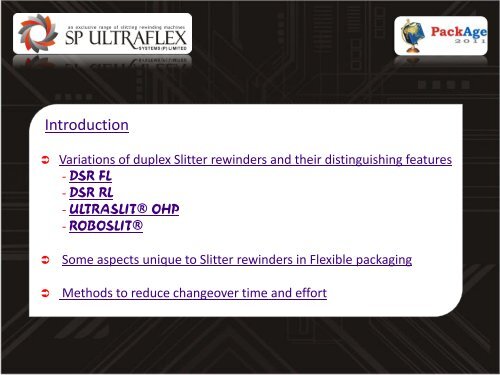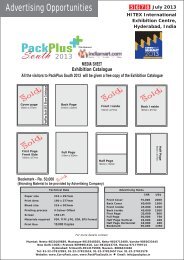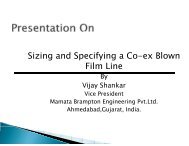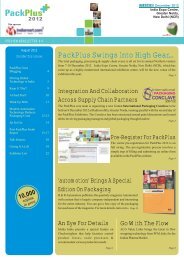Slitting Machines for Flexible Packaging Films ... - PackPlus South
Slitting Machines for Flexible Packaging Films ... - PackPlus South
Slitting Machines for Flexible Packaging Films ... - PackPlus South
You also want an ePaper? Increase the reach of your titles
YUMPU automatically turns print PDFs into web optimized ePapers that Google loves.
Introduction<br />
<br />
<br />
<br />
Variations of duplex Slitter rewinders and their distinguishing features<br />
- DSR FL<br />
- DSR RL<br />
- ULTRASLIT® OHP<br />
- ROBOSLIT®<br />
Some aspects unique to Slitter rewinders in <strong>Flexible</strong> packaging<br />
Methods to reduce changeover time and ef<strong>for</strong>t
SP Ultraflex has over two<br />
decades of gainful experience<br />
in the manufacture of <strong>Flexible</strong><br />
packaging and converting<br />
machines. In the year 2005,<br />
the management decided to<br />
hive off its Printing and<br />
Lamination machine business,<br />
to focus solely on the design<br />
and development of state of<br />
the art <strong>Slitting</strong> rewinding<br />
machines.
Undiverted focus, relentless improvements, constant innovations and an<br />
excellent support staff ensure that SP Ultraflex retains its position as the<br />
preferred supplier <strong>for</strong> <strong>Slitting</strong> rewinding machines.
Variations of duplex Slitter rewinders and their<br />
distinguishing features
Compact layout and easy web threading<br />
Excellent access to the cutting and trim extraction section<br />
One piece, pre-wired design with an integrated control cabinet to facilitate ease of<br />
transportation and quick installation<br />
Better overall supervision with minimum operator movement<br />
Speeds of upto 400 m/ min
Reasonably large unwind and rewind diameters in a compact layout<br />
<br />
<br />
<br />
Easy web threading<br />
One piece, pre-wired design with an integrated control cabinet to facilitate ease<br />
of transportation and quick installation<br />
Speeds of upto 500 m/min
Overhead bridge in place of the traditional foot bridge which ensures a hygienic<br />
environment, excellent access/ visibility and makes web threading easier<br />
<br />
<br />
Virtually endless possibilities of enhancements and upgrades in terms of material<br />
handling options, increased reel diameters, on line processes and other specific<br />
requirements<br />
Speeds of upto 600 m/ min
Dual turret rewinds which bring down the changeover time to less than 30 seconds by<br />
making it possible <strong>for</strong> other devices to execute the activities related to removal of<br />
finished reels and set up of new cores with the machine in operation<br />
<br />
<br />
These devices include a cross- cutting device, servo driven finished reels ejector, multi<br />
axis off loading mechanism and robotic core positioning system<br />
Robotic cutter positioning system while cutting in the Tangential rotary mode, resulting in<br />
a drastic reduction in the time and expertise required to change slit widths<br />
Horizontal orientation of the Lay on section ensures that the rewind reels are subjected to<br />
constant contact pressure as against the pivoted counterparts in which the contact angle<br />
changes with the rewind diameter
Some aspects unique to Slitter rewinders in <strong>Flexible</strong> packaging<br />
1. Downtime- futility of increase in speed<br />
As against this, changeovers on a secondary<br />
Changeovers on nonstop Rotogravure Presses<br />
and Lamination equipment occur only when<br />
switching from one job to another, making the<br />
cycle time <strong>for</strong> reel changeover irrelevant.<br />
On an average a changeover in a Rotogravure<br />
Press occurs twice in 24 hours, each<br />
changeover taking about 1.5 hours. Accordingly<br />
you can expect downtime to account <strong>for</strong> 15 %<br />
of the total time.<br />
Printing/ Lamination<br />
Slitter Rewinder are required with the build up<br />
of every rewind set, expiry of unwind reel and<br />
tooling changeovers.<br />
Considering an average of 9 minutes per cycle<br />
with 3 minutes run time, 4.5 minutes rewind<br />
changeover time and another 1.5 minutes being<br />
the proportionate allocation of unwind and<br />
tooling changeovers, we come to the eye<br />
opening conclusion that a duplex Slitter<br />
Rewinder has a downtime component which is<br />
as high as 64 %.<br />
Slitter rewinder<br />
15<br />
Runtime<br />
36<br />
Runtime<br />
85<br />
Downtime<br />
64<br />
Downtime
What this means is that the increase in<br />
output <strong>for</strong> a given increase in speed is<br />
quite substantial in the case of Printing<br />
and lamination machines. From the<br />
above example, we can see that<br />
increasing the speed in case of these<br />
processes will yield an increase in<br />
output which would be as much as 85%<br />
of the increase in speed. Say we<br />
increase the speed of a Printing Press by<br />
50% from 200 m/ min to 300 m/ min.<br />
The resulting increase in output would<br />
be 50 % of 85 % which is 42.5 %.<br />
Whereas increasing the speed in the case<br />
of the <strong>Slitting</strong> Rewinding operation will<br />
yield an increase in output which would<br />
be only 36% of the increase in speed.<br />
Say we increase the speed of a Printing<br />
press by 50 % from 400 m/ min to 600<br />
m/ min. The resulting increase in output<br />
would be 50 % of 36 % which is 18 %
2. Operator Fatigue<br />
The large diameters and lengths<br />
processed on Rotogravure Presses<br />
and Lamination equipment also<br />
mean that the cycle time is quite<br />
long and the operating personnel<br />
are rested <strong>for</strong> long stretches of time<br />
between material and changeover<br />
activities, keeping them relatively<br />
fresh during the course of the shift.<br />
As against this, the operating personnel on a duplex Slitter<br />
Rewinder would be required to carry out the strenuous<br />
activity of rewind reel changeovers once in every 10<br />
minutes, 6 times in an hour and 144 times in a 24 hours<br />
day. Add to this the fact that unlike Printing and<br />
Lamination equipment, the operator has to physically<br />
displace and lower to ground level not just one but several<br />
rewound reels during each cycle. As a result a marked drop<br />
in output levels is observed as the shift progresses, both<br />
due to physical fatigue and the tendency of the operator to<br />
increase the cycle time by lowering machine speeds.
3. Factors restricting high speed operation<br />
Being primary converting operations, Printing<br />
and Lamination processes can usually be<br />
carried out at constant speeds near the rated<br />
machine speed, mainly on account of the fact<br />
that these machines, in particular the Printing<br />
press is equipped with Automatic registration<br />
control, Defect detection systems, Viscosity<br />
controls and other such equipment with<br />
which there is a minimal need to reduce the<br />
machine speeds <strong>for</strong> any reason.<br />
On the other hand, the material being<br />
converted on the Slitter rewinder has<br />
gone through a number of processes<br />
and contains portions with defects<br />
which are marked. The Slitter<br />
rewinder is often slowed down or<br />
sometimes even stopped to examine/<br />
remove these defects.
4. Need to bring down ramp times<br />
As the graph below illustrates, even when the machine is running, full rated speed is maintained <strong>for</strong> only<br />
about 60% of the run time; the remaining 40% is the time taken to accelerate to and de-accelerate from<br />
the steady speed. Hence reducing the acceleration and de- acceleration times assumes much greater<br />
importance than in the case of non- stop Printing and Lamination operations. Servo motors, higher end<br />
drives and complicated programming algorithms need to be used to achieve this objective. It is in fact the<br />
Slitter rewinder, due to the frequent stop- start conditions, where the per<strong>for</strong>mance and ruggedness of<br />
drives are truly put to the test.
5. The quality aspect – importance of quality <strong>Slitting</strong> rewinding<br />
equipment<br />
Last but not the least, the <strong>Slitting</strong> operation is in most cases the<br />
final process after which the finished reels are dispatched to the<br />
customer. It is the look and finish of the slit reels which first<br />
catches the eye of the customer.<br />
Hence the importance of good quality <strong>Slitting</strong> rewinding equipment<br />
cannot be over- emphasized in the overall set up of a <strong>Flexible</strong><br />
packaging and converting unit.
Methods to reduce changeover time and ef<strong>for</strong>t<br />
Rewind changeover- Fully automatic<br />
Single touch operation <strong>for</strong><br />
ejection of reels onto an off<br />
loader which swivels in two<br />
planes be<strong>for</strong>e lowering the<br />
reels to floor level. Reduces<br />
changeover time by about 2<br />
minutes.
Rewind changeover- Semi automatic<br />
180° Indexing <strong>for</strong> easier<br />
removal- brings the reels of the<br />
upper rewind to a more<br />
manageable level <strong>for</strong> ease of<br />
removal
Rewind changeover- Pneumatic swivel<br />
Pneumatically actuated Off loader <strong>for</strong><br />
rewind reels, interlocked with the<br />
machine controls <strong>for</strong> safety and attached<br />
to the main machine to reduce floor space<br />
requirements and installation time.
Pick and place mechanism to<br />
position the fresh cores as<br />
stored in the job recipe with the<br />
machine in operation.<br />
Robotic core positioning
Unwind floor lift<br />
Shaftless, self<br />
centering floor lift<br />
mechanism<br />
conceived without<br />
the use of hydraulics<br />
to meet the hygiene<br />
requirements <strong>for</strong><br />
secondary<br />
packaging.<br />
More convenient<br />
trajectory of lifting<br />
movement which is<br />
vertical, as against<br />
angular in most<br />
contemporary<br />
machines.
This activity consumes a<br />
lot of time, especially in<br />
case of rotary knives. A<br />
tangent cut system<br />
without separating spacers<br />
reduces set up time.<br />
More advanced solutions<br />
include pick and place<br />
mechanisms to position<br />
the cutters cores precisely<br />
and as in the job recipe.<br />
Slit size change
Slit mode change<br />
A well designed<br />
cutting section<br />
includes features to<br />
reduce the time and<br />
man power required<br />
to change from one<br />
slit mode to the<br />
other.
Replacement of worn slitting tools<br />
Rotary top cutter change<br />
Razor blade change
THANK YOU FOR YOUR ATTENTION










